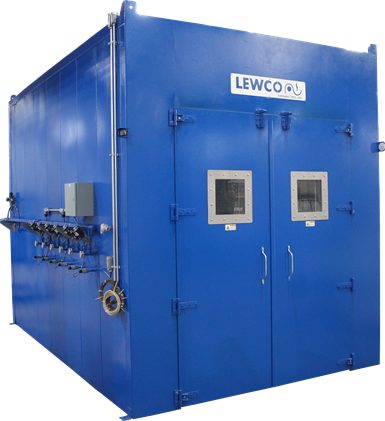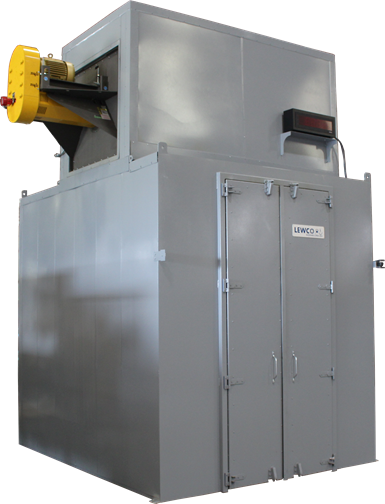Lewco supplies custom composites curing ovens for aerospace
Lewco Inc. recently supplied ovens to three customers ranging from a research laboratory to an aircraft manufacturer.
Lewco Inc., (Sandusky, Ohio, U.S.) a manufacturer of composites curing ovens, recently supplied ovens to three customers ranging from a research laboratory to an aircraft manufacturer. The ovens varied in size and capability, and they were custom made for each of the respective customers.
Lewco commissioned a large 500°F vacuum-assisted composite curing (VACC) oven to a national research laboratory, which researchers use to cure various composite parts. The electric walk in-oven features a rear mounted heater box with a heat capacity of 99 kilowatts. The oven is equipped with a 18,000 cubic feet per minute (CFM) high-efficiency circulation fan, which reportedly delivers dual airflow and provides uniform heat throughout the workspace. A temperature uniformity survey reported that the oven exceeded customer specifications of ±10°F by achieving better than ±5°F at maximum temperature.
In addition, Lewco delivered a 650°F enhanced duty electric batch oven to a world-class aircraft manufacturer. Lewco says this oven is unique as it is used for two applications: curing various aerospace composite parts and heating parts up to a maximum temperature of 650°F. The walk-in oven features a top-mounted heater box with 144-kilowatt heat capacity. The oven is equipped with a 22,000 CFM high-efficiency circulation fan that reportedly delivers dual airflow and provides uniform heat throughout the workspace. Due to some of the parts containing solvents, the oven is rated for NFPA 86, Class A and includes a 500 CFM exhaust fan. The oven is furnished with lanyards to hold the doors open while personnel enter the oven. An e-stop pull cord is included inside the oven to immediately power down the oven in case of entrapment. Included are four ½-inch national piper tapers (NPT) through wall vacuum ports with manual shut-off valves and dial pressure gauges on the exterior. All ports are connected to a 1-inch NPT common header pipe for a single connection to the customer’s vacuum source. Lewco says the customer required the oven to meet strict temperature uniformity requirements of ±10°F at an operating temperature of 650°F. A nine-point temperature uniformity test was conducted, and results were within the specifications.
Lastly, Lewco designed and manufactured an 800°F electrically heated walk-in oven that is used primarily for curing honeycomb composite structures; it also has capability for vacuum assisted composite curing. The enhanced duty batch oven features a top mounted heater-box with 180 kilowatts of heat capacity. The oven is equipped with a 24,000 CFM high-efficiency circulation fan that delivers horizontal airflow and provides uniform heat throughout the workspace. A variable speed drive is included on the exhaust fan for controlled cooling cycles and shorter purge time. The airflow volume of the oven is designed to meet strict temperature uniformity requirements. A nine-point temperature uniformity survey was conducted at 500°F and 750°F to ensure that customer requirements for their specific process have been met. Lewco says the temperature uniformity survey exceeded customer specifications of ±10°F by achieving better than ±5°F.
Related Content
A new era for ceramic matrix composites
CMC is expanding, with new fiber production in Europe, faster processes and higher temperature materials enabling applications for industry, hypersonics and New Space.
Read MoreManufacturing the MFFD thermoplastic composite fuselage
Demonstrator’s upper, lower shells and assembly prove materials and new processes for lighter, cheaper and more sustainable high-rate future aircraft.
Read MoreMaterials & Processes: Fabrication methods
There are numerous methods for fabricating composite components. Selection of a method for a particular part, therefore, will depend on the materials, the part design and end-use or application. Here's a guide to selection.
Read MoreLarge-format 3D printing enables toolless, rapid production for AUVs
Dive Technologies started by 3D printing prototypes of its composite autonomous underwater vehicles, but AM became the solution for customizable, toolless production.
Read MoreRead Next
From the CW Archives: The tale of the thermoplastic cryotank
In 2006, guest columnist Bob Hartunian related the story of his efforts two decades prior, while at McDonnell Douglas, to develop a thermoplastic composite crytank for hydrogen storage. He learned a lot of lessons.
Read MoreCW’s 2024 Top Shops survey offers new approach to benchmarking
Respondents that complete the survey by April 30, 2024, have the chance to be recognized as an honoree.
Read MoreComposites end markets: Energy (2024)
Composites are used widely in oil/gas, wind and other renewable energy applications. Despite market challenges, growth potential and innovation for composites continue.
Read More


























